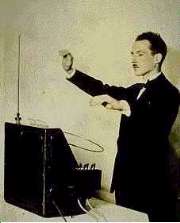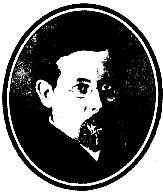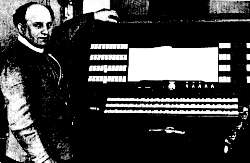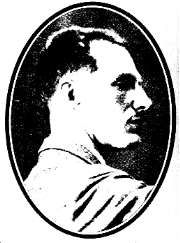 Nowadays,
referring to electronic music almost amounts to
speaking about music. Few are the works, not
only in the Pop trends but also within all kinds
of music currently being composed, in which no electronically
generated sound appears.
Nowadays,
referring to electronic music almost amounts to
speaking about music. Few are the works, not
only in the Pop trends but also within all kinds
of music currently being composed, in which no electronically
generated sound appears.THE
REVOLUTION OF ELECTRONICS
WITHIN MUSIC
Chapter 1: PRESENTATION
AND ORIGINS
By: Jorge Munnshe
This is part one of a series of six chapters devoted to the history of electronic music, which will be appearing during the next months.
* * * * * *
 Nowadays,
referring to electronic music almost amounts to
speaking about music. Few are the works, not
only in the Pop trends but also within all kinds
of music currently being composed, in which no electronically
generated sound appears.
Nowadays,
referring to electronic music almost amounts to
speaking about music. Few are the works, not
only in the Pop trends but also within all kinds
of music currently being composed, in which no electronically
generated sound appears.
There still exist some people who claim that electronics diminishes creativity in music. Yet the fact is that formerly composers had to wait for an orchestra to decide to play their music in order to listen to their own symphony, whereas today, thanks to synthesizers, sequencers and computers, they can listen to their creations before having them released for the audience. The musical creativity of the composer has experienced an impressive leap. Today, the author can compose without the wearisome mediation of scores, a knowledge of musical notation and all that. Composers can play all the instruments that appear in their work, and design them as they please, which means they do not limit themselves to creating notes, but also they can create new sounds. They can even generate and play on the keyboard voices, choirs, rains, winds, birdsongs and every sound we get in our universe, thanks to the samplers. Their control is absolute. They have in their hands the power to express everything that comes out of their creativity.
THE DIFFERENT TRENDS
Electronic music, either
synthesized or computer-generated, has no definite style per se.
It is music performed by electronic instruments. Nevertheless,
and even if these are routinely used nowadays, there exist some
given trends which are more inclined to using them than others,
or that may have been or still may be pioneer in their time.
Perhaps the most representative one may be the increasingly
growing number of styles gathered under the label of New
Age, which would include Cosmic Music, World
Music, and others. Next I offer a review of the styles
more directly related to electronics.
TECHNO. This is the most widely known style of all those that are related to electronics. It is unnecessary to explain what it consists in. What maybe not everybody knows is what its origin was. Techno was gestated by the late 1960s and was born in the early 1970s. Germany was its cradle, and its paternity is attributed to the band Kraftwerk, that in 1971 already made Techno music.
PSYCHEDELIC, SYMPHONIC AND / OR SPACE ROCK. This is a style which has become quite well known, and that has in its history such names as Pink Floyd, King Crimson, Genesis and others. We could also include under this label (although not in an exclusive way) Mike Oldfield, Peter Gabriel, and other pop artists very difficult to classify who have had a tight relationship with the electronic universe. The boom of these kinds of rock took place in the '60s, with Pink Floyd as the visible head of the most avant-garde sector, and reached its maturity in the '70s. These styles could be considered as the forefathers of Techno.
SPACE MUSIC. Also called Cosmic or Ambient, and known in its beginnings as New German Rock, since it was in Germany where it sprouted with utmost strength. Its origins are very complicated. If we look at the art rather than at the technology, Bach, Debussy or Wagner could have been doing this kind of music. In actual fact, the typical cosmic music is a fusion of classicism and new musical structures, which incorporates dreamy melodies and complex rhythms. Space Music is the style more markedly electronic in nature than any others. It often plays the role of test-bed for synthesizer prototypes, and is the addressee for a great deal of the most sophisticated musical technology. The big explosion of musical technology in the seventies had in Cosmic Music its great receiver.
ELECTROACOUSTIC / CONCRETE MUSIC. This current, in its continual search for new sonic paths to be explored, produced the most memorable series of explorers of electronic music prior to the appearance of the first synthesizers to be manufactured on a large scale. People like Milton Babbit or Mauricio Kagel, amongst others, are pioneers in the production of exclusively electronic music.
MINIMALIST MUSIC. It could be described as repetitive music that has inherited something from Electroacoustic Music and something from Space Music. Among the most noteworthy artists in this trend we can name Steve Reich and Philip Glass.
ELECTRONIC JAZZ. As is well known, within Jazz there exist numerous styles. Some of them can be labelled as Electronic Jazz, since in them the typical instruments of Jazz have been either partly or totally replaced by synthesizers. The clearest example is the Brazilian composer Wagner Tiso.
Apart from these genres, others have also benefited from synthesizers and other advanced electronic instruments as well, although to a much lesser extent. Even Classical Music!! has had memorable electronic recordings. Although the classical composers did not have access to synthesizers in their time, theirs, and more particularly that of certain authors, is a music that easily lends itself to being performed by means of a synthesizer. This is why the works by Bach interpreted at the synthesizer by Wendy Carlos were so successful in the late sixties. Or those of Debussy, Stravinsky, Prokofiev, Strauss and others performed by Isao Tomita.
We could continue to try labelling to define different styles within each one of these trends, yet this would amount to labelling for the sake of labelling. The very same impossibility to define music with words very often makes the labels ambiguous, and therefore it is only advisable to use them to define very wide fields. No doubt the only precise label is that of each author.
 THE
PREHISTORY
THE
PREHISTORY
The beginnings of electronic
music get back to far sooner than is normally believed.
Precisely, they must be placed in the late nineteenth century,
when in a rather unnoticed way for the audience of those times,
strange musical instruments of a partially electronic nature,
such as the Electronic Harpsichord, the Electromagnetic Pianos or
the Singer Arc, were created. The references that have been kept
till our days are scarce and confused, since such inventions did
not receive on the part of society a larger attention than that
which is given to strange gizmos typical of a sensationalist
fair. Even so, in Germany there already existed some technical
journalists who prophesized the birth of electronic music,
claiming, before the uncomprehension and the mockery of their
peers, that electricity would be in the future responsible for a
thorough turn in the instrumental conception of music.
The first instrument of an entirely
electronic nature was the Telharmonium, invented in 1900 by Thaddeus
Cahill. The music played with this instrument was
transmitted via delivery service to those who were interested in
it through the telephone nets. This fact meant besides, that this
was the first experience of Piped Music. These were important
achievements for an important time. That was the era in which the
scientific spirit that would make the revolution of the
electronic instruments possible within the music world as the
decades went by sprouted, from the simplest ones like the
electric guitar and organ, to the most complex ones such as the synthesizer and the sampler.
Nevertheless, during those years, the electronic instruments and
the electronic music itself were the exclusive domain of solitary
inventors, as a general rule uncomprehended by a Victorian
society clinging to the traditional musical concepts.
the most complex ones such as the synthesizer and the sampler.
Nevertheless, during those years, the electronic instruments and
the electronic music itself were the exclusive domain of solitary
inventors, as a general rule uncomprehended by a Victorian
society clinging to the traditional musical concepts.
THE AMAZING TWENTIES
After World War One, a
remarkable increase in new electronic instruments took place. In
Germany, Jorg Mager invented an electronic
instrument without a keyboard, whose notes were determined by
turning a handle that regulated the frequency of the sound. He
also built an electronic organ with three keyboards, which
incorporated different timbres, as well as the kaleidophone, a
monophonic instrument with a keyboard that allowed the performer
to mix sounds.
The Russian musician Lev Termen (or Lev Theremin in its French transcription) created the Termenvox, also known as Theremin (derived from his surname). This instrument lacked a keyboard. The notes sounded by moving the hands before some aerials that sprouted from the device, thus rendering this instrument a singular mechanism to perform music which reminds us of the Laser Harp played by Jean Michel Jarre. The electronic instruments multiplied.
 The
Terpsitone was some sort of elder brother to the Termenvox, able
to widen its musical range to the movement of the entire body,
which meant that this instrument was played by means of dance.
The Rythmicon was a predecessor of the current sequencers.
Besides these instruments, Lev Termen designed
an electronic cello, a primitive drum machine, and an electronic
instrument supplied with a keyboard. Hugo Gernsback,
the inventor of the term science-fiction, and an
editor of narrations within this genre, designed the Pianorad,
supplied with a polyphonic keyboard.
The
Terpsitone was some sort of elder brother to the Termenvox, able
to widen its musical range to the movement of the entire body,
which meant that this instrument was played by means of dance.
The Rythmicon was a predecessor of the current sequencers.
Besides these instruments, Lev Termen designed
an electronic cello, a primitive drum machine, and an electronic
instrument supplied with a keyboard. Hugo Gernsback,
the inventor of the term science-fiction, and an
editor of narrations within this genre, designed the Pianorad,
supplied with a polyphonic keyboard.
In France there appeared the electronic organ Givelet-Coupleaux, which supplied up to 76 different sounds, and the Ondes Martenot, which had a success lasting enough to earn its own post among the conventional musical instruments.
The success of the music played with such singular instruments is soon remarkable enough. Lev Termen gives live tours all over Europe, and settles in the USA. He plays his instruments with the Philarmonic Orchestra of New York.
 Musicians
specialized in electronic music then appear, such as for instance Clara
Rockmore, a legendary virtuoso player of Termenvox.
Works of electronic (or semielectronic) music are composed, as
for instance Electric Symphony (1932), or Symphonic
Mystery for Termenvox and Orchestra (1924), besides
different movie soundtracks.
Musicians
specialized in electronic music then appear, such as for instance Clara
Rockmore, a legendary virtuoso player of Termenvox.
Works of electronic (or semielectronic) music are composed, as
for instance Electric Symphony (1932), or Symphonic
Mystery for Termenvox and Orchestra (1924), besides
different movie soundtracks.
THE DECADENCE
The great interest that in
the industrialized society the electronic instruments awoke since
they were a surprising technical novelty, died out by the late
thirties. And given the fact that the music they played was
either conventional, or too complex and disperse, the embryonic electronic
music ceased to attract the general audience of that
time. There existed the technology, but there was not a
sufficient artistic-cultural background to allow for taking
advantage of it so as to create a wholly different music, whose
essence were found in the soul of this technology, rather that in
adaptations of styles developed based on acoustic instruments.
The technical progress so far achieved was too far ahead from the
cultural progress of the times.
Because of all that, the commotion created by electronic music ceased by the end of the 1930s. Lev Termen returned to the USSR. Jorg Mager died. The beginning of World War II directed the attention of the society to more pressing issues other than the research in new musical languages, and the waters of forgetfulness swallowed the key that could have opened a new musical universe decades before the times when this was finally possible.
Next:
Chapter 2: Towards a musical revolution.